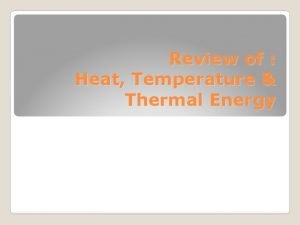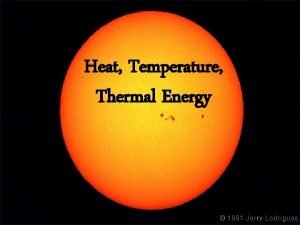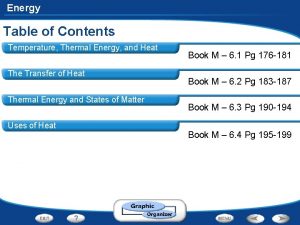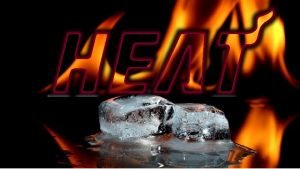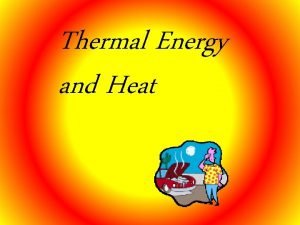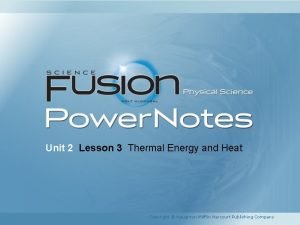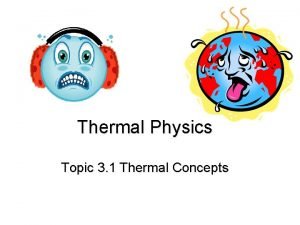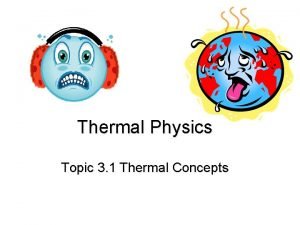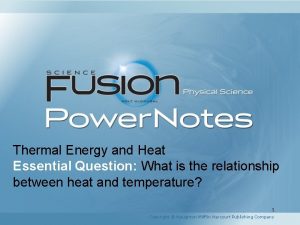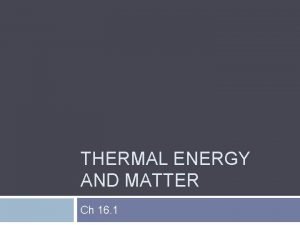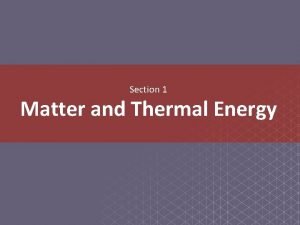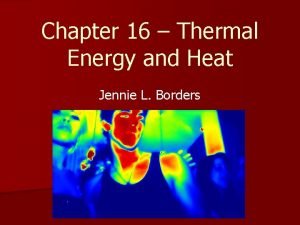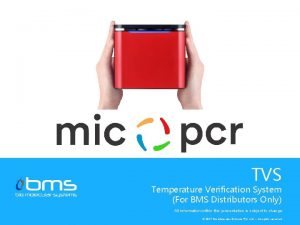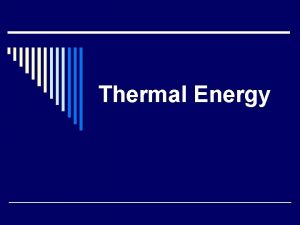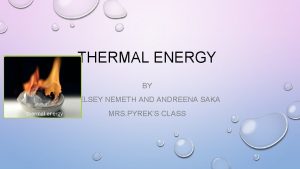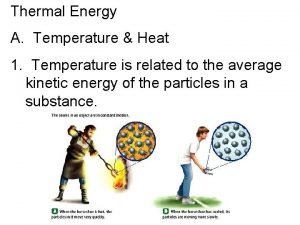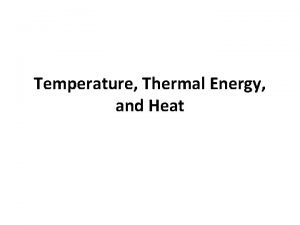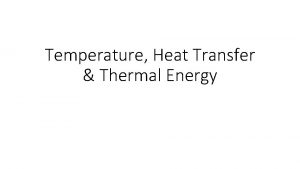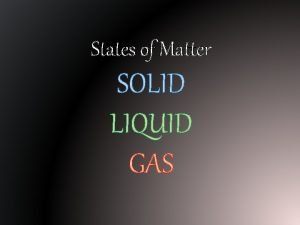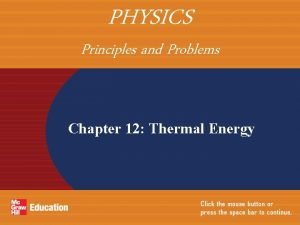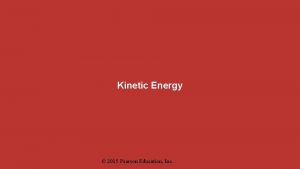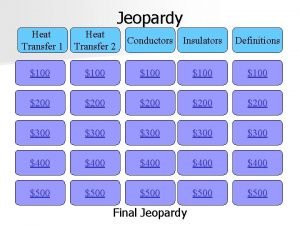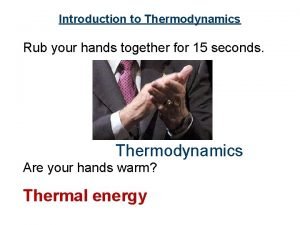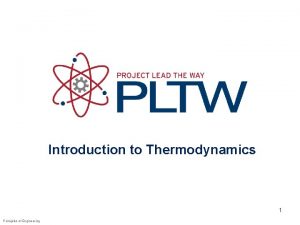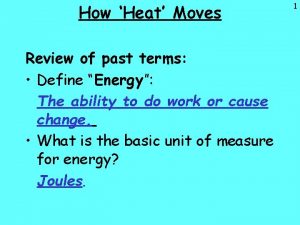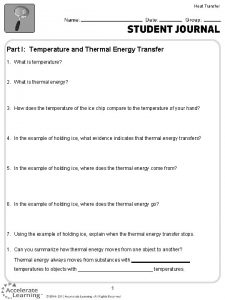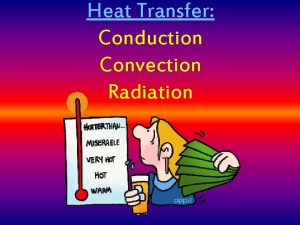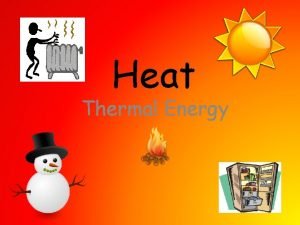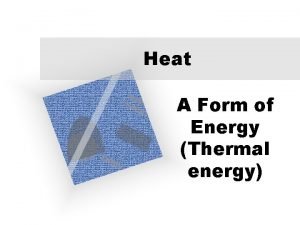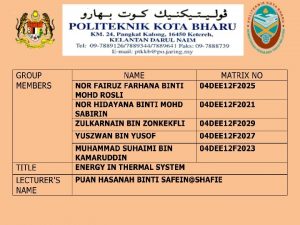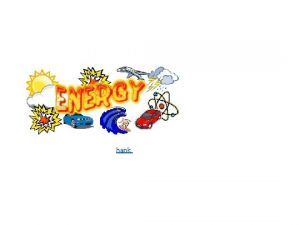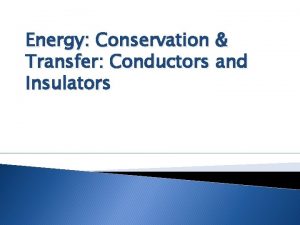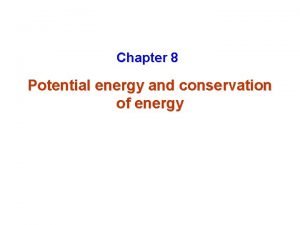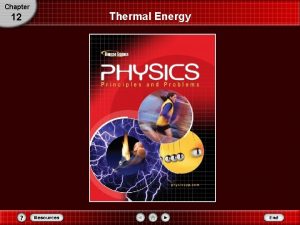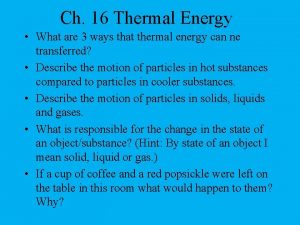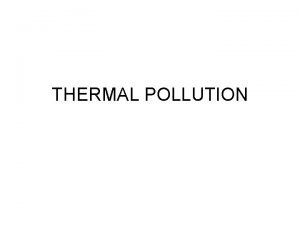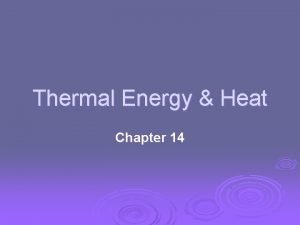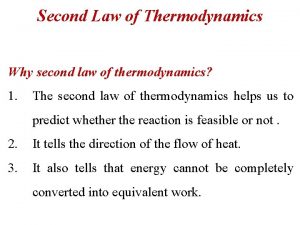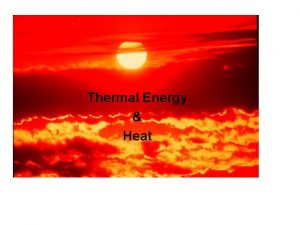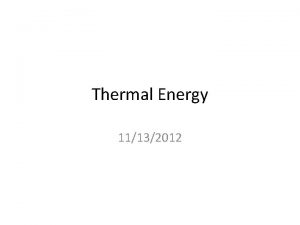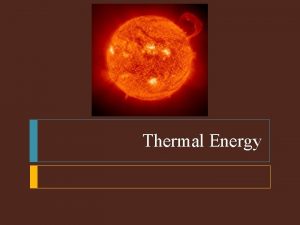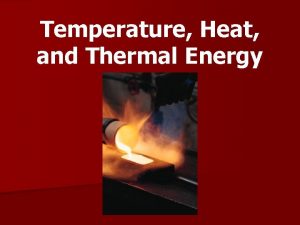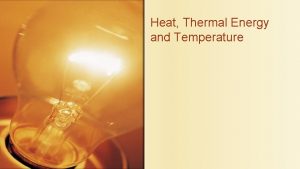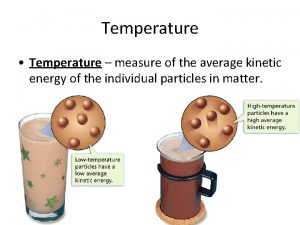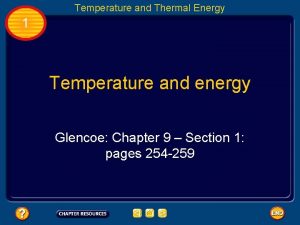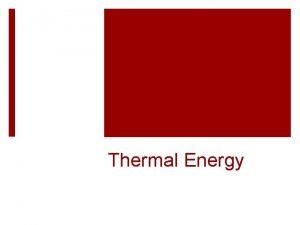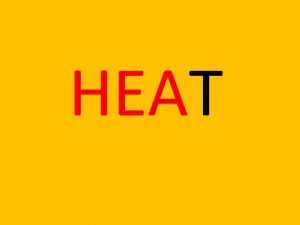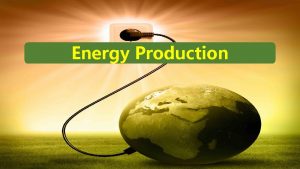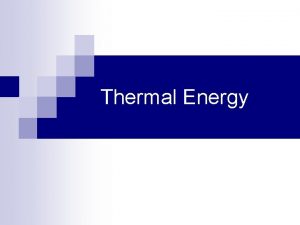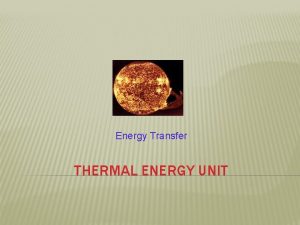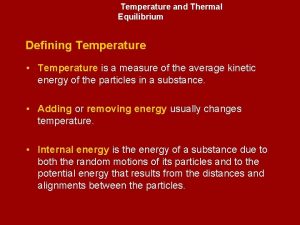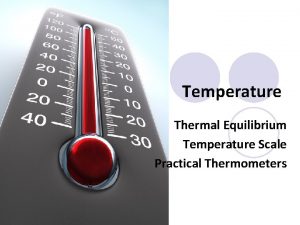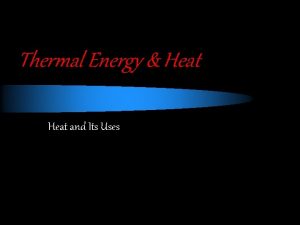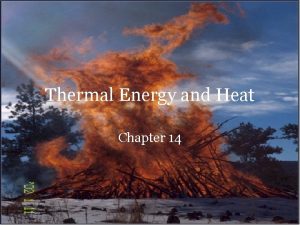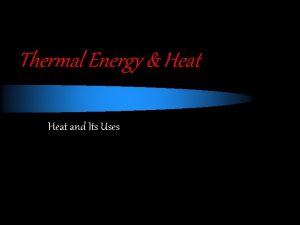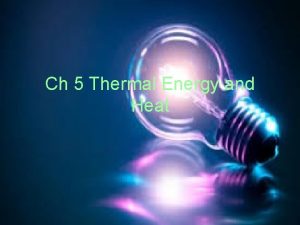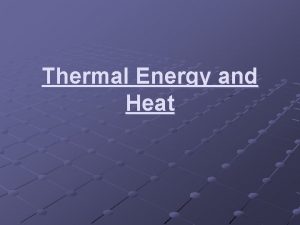Temperature and Thermal Energy 1 Temperature Temperature is


















































- Slides: 50

Temperature and Thermal Energy 1 Temperature • Temperature is a measure of the average kinetic energy of the particles in an object • The more kinetic energy the molecules have, the higher the temperature. • Remember that matter is made up of tiny particles that are always moving, so these particles have kinetic energy

Temperature and Thermal Energy 1 Temperature • The higher the temperature, the faster the molecules are moving.

Temperature and Thermal Energy 1 Thermal Expansion • When the temperature of an object is increased, its molecules speed up and tend to move farther apart. • This causes the object to expand.

Temperature and Thermal Energy 1 Thermal Expansion • When the object is cooled, its molecules slow down and move closer together. • This causes the object to shrink, or contract.

Temperature and Thermal Energy 1 Thermal Expansion • The amount of expansion or contraction depends on the type of material and the change in temperature. • Liquids usually expand more than solids.

Temperature and Thermal Energy 1 Measuring Temperature • The temperature of an object depends on the average kinetic energy of all the molecules in an object. • It is impossible to measure the kinetic energy of all the individual molecules.

Temperature and Thermal Energy 1 Measuring Temperature • A more practical way to measure temperature is to use a thermometer. • Thermometers usually use the expansion and contraction of materials to measure temperature.

Temperature and Thermal Energy 1 Converting Fahrenheit and Celsius • You can convert temperatures back and forth between the two temperature scales by using the following equations.

Temperature and Thermal Energy 1 Thermal Energy • Molecules also have potential energy. • Potential energy is energy that the molecules have that can be converted into kinetic energy. • The sum of the kinetic and potential energy of all the molecules in an object is thermal energy of the object.

Temperature and Thermal Energy 1 The Potential Energy of Molecules • The molecules in a material exert attractive forces on each other. • As a result, the molecules in a material have potential energy. • As the molecules get closer together or farther apart, their potential energy changes.

Temperature and Thermal Energy 1 Increasing Thermal Energy • Temperature and thermal energy are different. • Suppose you have two glasses filled with the same amount of milk, and at the same temperature. • If you pour both glasses of milk into a pitcher, the temperature of the milk won’t change.

Temperature and Thermal Energy 1 Increasing Thermal Energy • However, because there are molecules of milk in the pitcher than in either glass, thermal energy of the milk in the pitcher is greater than thermal energy of the milk in either glass.

How is Thermal Energy Different from temperature • Temperature, thermal energy, and heat are closely related but they are not the same thing. • Temperature is a measure of the average kinetic energy of the individual particles in an object. But temp. is not a measure of the total amount of energy in an object. • Thermal energy is the total energy of all the particles in an object. • In other words, thermal energy is the total kinetic energy and potential energy of the particles in an object. That is particles in objects are constantly in motion. This means they have Kinetic energy. These particles are arranged in specific ways in specific objects, so they have potential energy.

Thermal Energy • Thermal energy depends on the objects temperature, the number of particles in the object and how those particles are arranged • Ex: a 1 - liter pot of tea at 75˚ C has more thermal energy than a 0. 2 -liter mug of tea at 75° C because the pot contains more tea particles.

Section Check 1 Question 1 Which of the following does NOT depend on how fast the molecules in a substance are moving? A. kinetic energy B. thermal energy C. potential energy D. temperature FL: SC. A. 1. 3. 3

Section Check 1 Answer FL: SC. A. 1. 3. 3

Section Check 1 Question 2 When the temperature of an object is increased, molecules in the substance speed up and move _____. A. toward the surface B. away from the surface C. closer together D. farther apart FL: SC. A. 1. 3. 3

Section Check 1 Answer . FL: SC. A. 1. 3. 3

Section Check 1 Question 3 The two most common temperature scales are the _______ and the _______ scale. FL: SC. A. 1. 3. 3, SC. H. 1. 3. 4

Answer

Heat 2 Heat and Thermal Energy • Heat is thermal energy that is transferred from one object to another when the objects are at different temperatures. • The amount of heat that is transferred when two objects are brought into contact depends on the difference in temperature between the objects.

Heat 2 Transfer of Heat • When heat is transferred, thermal energy always moves from warmer to cooler objects. • Heat never flows from a cooler object to a warmer object. • This process of heat transfer can occur in three ways—by conduction, radiation, or convection.

Heat 2 Conduction • Transfer of heat by direct contact is called conduction. • Conduction occurs when particles in a material collide with neighboring particles.

Heat 2 Conduction • Imagine holding an ice cube in your hand. • The faster-moving molecules in your warm hand bump against the slowermoving molecules in the cold ice.

Heat 2 Conduction • Heat flows from your warmer hand to the colder ice, and the slowmoving molecules in the ice move faster. • As a result, the ice becomes warmer and its temperature increases.

Heat 2 Conduction • Conduction usually occurs most easily in solids and liquids, where atoms and molecules are close together. • Then atoms and molecules need to move only a short distance before they bump into one another and transfer energy.

Heat 2 Radiation • Heat is transferred from the Sun to Earth by radiation. • Heat transfer by radiation occurs when energy is transferred by electromagnetic waves.

Heat 2 Radiation • The transfer of thermal energy by radiation can occur in empty space, as well as in solids, liquids, and gases.

Heat 2 Radiation • The Sun is not the only source of radiation. • All objects emit electromagnetic radiation, although warm objects emit more radiation than cool objects. • The warmth you feel when you sit next to a fireplace is due to heat transferred by radiation from the fire to your skin.

Heat 2 Convection • In a gas or liquid, molecules can move much more easily than they can in a solid. • As a result, the more energetic molecules can travel from one place to another, and carry their energy along with them. • This transfer of thermal energy by the movement of molecules from one part of a material to another is called convection.

Heat 2 Transferring Heat by Convection • As a pot of water is heated, heat is transferred by convection. • First, thermal energy is transferred to the water molecules at the bottom of the pot from the stove. • These water molecules move faster as their thermal energy increases.

Heat 2 Transferring Heat by Convection • Because the molecules are farther apart in the warm water, this water is less dense than the cooler water. • As a result, the warm water rises and is replaced at the bottom of the pot by cooler water. • The cooler water is heated, rises, and the cycle is repeated until all the water in the pot is at the same temperature.

Heat 2 Natural Convection • Natural convection occurs when a warmer, less dense fluid is pushed away by a cooler, denser fluid. • Wind movement near a lake or ocean can result from natural convection. • Air is heated by the land becomes less dense.

Heat 2 Natural Convection • Denser cool air rushes in, pushing the warm water up. • The cooler air then is heated by the land the cycle is repeated.

Heat 2 Thermal Conductors • A conductor is any material that easily transfers heat. • Some materials are good conductors because of the types of atoms or chemical compounds they are made up of.

Heat 2 Thermal Conductors • Certain materials, such as metals, have some electrons that are not held tightly by the nucleus and are freer to move around. • These loosely held electrons can bump into other atoms and help transfer thermal energy. • The best conductors of heat are metals such as gold and copper.

Heat 2 Thermal Insulators • An insulator is a material in which heat doesn’t flow easily. • Liquids and gases are usually better insulators than solids are. • Air is a good insulator, and many insulating materials contain air spaces that reduce the transfer of heat by conduction within the material.

Heat 2 Thermal Insulators • Materials that are good conductors, such as metals, are poor insulators, and poor conductors are good insulators. • Houses and buildings are made with insulating materials to reduce heat conduction between the inside and outside.

Heat 2 Thermal Insulators • Fluffy insulation is put in the walls. • Some windows have double layers of glass that sandwich a layer of air or other insulating gas.

Section Check 2 Question 1 When heat moves from one object to another as a result of direct contact, the process is known as _______. A. conduction B. convection C. radiation D. expansion FL: SC. B. 1. 3. 5

Section Check 2 Answer The answer is A. Conduction is occurring when you hold a cup of hot chocolate and feel the warmth in your hand. FL: SC. B. 1. 3. 5

Section Check 2 Question 2 Heat can be transferred through empty space only by _____. A. convection B. forced convection C. radiation D. conduction FL: SC. B. 1. 3. 3

Section Check 2 Answer The answer is C. Heat is transferred from the Sun to Earth by radiation. FL: SC. B. 1. 3. 3

Section Check 2 Question 3 When water in a cooking pot on a stove is heated, the water at the bottom becomes warmer than the water above. The warm water is less dense and rises, cooling as it transfers thermal energy to the cooler water above. As this water cools, it becomes more dense and sinks to the bottom of the pot. This process is an example of the transfer of thermal energy by _____. FL: SC. A. 2. 3. 3, SC. B. 1. 3. 5

Section Check 2 A. radiation B. convection C. insulation D. thermal pollution FL: SC. A. 2. 3. 3, SC. B. 1. 3. 5

Section Check 2 Answer The answer is B. Convection occurs when thermal energy is transferred by the movement of molecules from one place to another in a material. FL: SC. A. 2. 3. 3, SC. B. 1. 3. 5

Engines and Refrigerators 3 Forms of Energy • Chemical energy is energy stored in the chemical bonds between atoms. • Radiant energy is the energy carried by electromagnetic waves.

Engines and Refrigerators 3 Forms of Energy • Nuclear energy is energy stored in the nuclei of atoms. • Electrical energy is the energy carried by electric charges as they move in a circuit.

Engines and Refrigerators 3 The Law of Conservation of Energy • When energy is transformed from one form to another, the total amount of energy doesn’t change. • According to the law of conservation of energy, energy cannot be created or destroyed. • Energy only can be transformed from one form to another.

Section Check 3 Question 1 What is the law of conservation of energy? Answer According to the law of conservation of energy, energy can never be created or destroyed. Energy only can be changed from one form into other forms. FL: SC. B. 1. 3. 2
 Section 3 using heat worksheet answers
Section 3 using heat worksheet answers Thermal energy in states of matter
Thermal energy in states of matter Heat thermal energy and temperature
Heat thermal energy and temperature Heat flow
Heat flow Thermal energy vs heat energy
Thermal energy vs heat energy Thermal energy vs heat
Thermal energy vs heat Thermal energy vs temperature
Thermal energy vs temperature Thermal energy vs temperature
Thermal energy vs temperature Is temperature a measure of thermal energy
Is temperature a measure of thermal energy Thermal energy and mass
Thermal energy and mass Thermal transfer vs direct thermal printing
Thermal transfer vs direct thermal printing Energy energy transfer and general energy analysis
Energy energy transfer and general energy analysis Energy energy transfer and general energy analysis
Energy energy transfer and general energy analysis What is the difference between thermal energy and heat?
What is the difference between thermal energy and heat? Difference between heat and thermal energy
Difference between heat and thermal energy Difference between heat and thermal energy
Difference between heat and thermal energy Difference between heat and thermal energy
Difference between heat and thermal energy Mass and thermal energy
Mass and thermal energy Which reverses the normal flow of thermal energy
Which reverses the normal flow of thermal energy Matter and thermal energy section 1
Matter and thermal energy section 1 Lesson outline lesson 1 solids liquids and gases answer key
Lesson outline lesson 1 solids liquids and gases answer key Chapter 16 thermal energy and heat
Chapter 16 thermal energy and heat Thermal cycler temperature verification system
Thermal cycler temperature verification system Which is the best surface for reflecting heat radiation
Which is the best surface for reflecting heat radiation Thermal energy depends on
Thermal energy depends on Whats thermal energy
Whats thermal energy Define thermal energy
Define thermal energy Thermal vs heat energy
Thermal vs heat energy How to measure heat energy
How to measure heat energy Example of heat energy
Example of heat energy Thermal energy states of matter
Thermal energy states of matter Chapter 12 study guide thermal energy
Chapter 12 study guide thermal energy Thermal energy formula
Thermal energy formula Rubber is a good insulator of blank
Rubber is a good insulator of blank Energy transfer equation
Energy transfer equation Thermal energy formula
Thermal energy formula Define thermal energy
Define thermal energy Types of thermal energy transfers
Types of thermal energy transfers Types of heat transfer
Types of heat transfer Sources of heat
Sources of heat Calculating thermal energy
Calculating thermal energy Conclusion energy in thermal system
Conclusion energy in thermal system Nuclear energy examples
Nuclear energy examples Thermal energy examples
Thermal energy examples Gravitational potential energy
Gravitational potential energy Chapter 12 thermal energy answers
Chapter 12 thermal energy answers Examples of thermal kinetic energy
Examples of thermal kinetic energy Foldable definition
Foldable definition Thermal pollution control
Thermal pollution control Use of heat
Use of heat A thermal energy reservoir (ter) has
A thermal energy reservoir (ter) has


